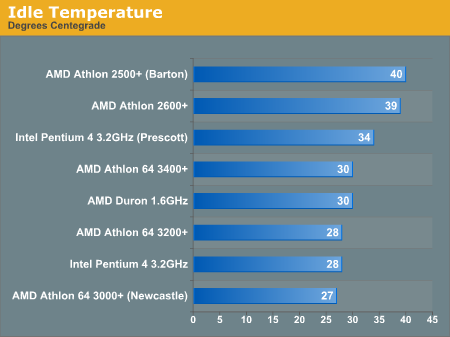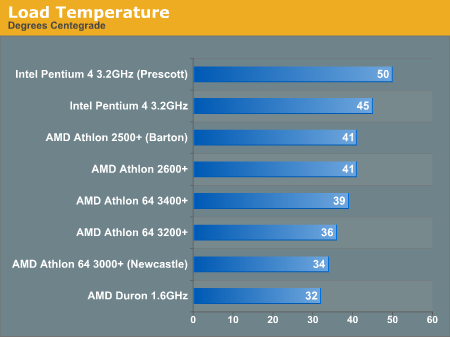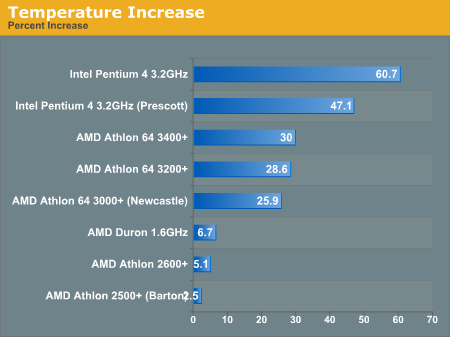CPU Heat Comparison: How Hot is Prescott?
by Derek Wilson on April 16, 2004 4:32 AM EST- Posted in
- CPUs
Processor Temperature Comparisons

We can see that, at idle, Prescott is 6 degrees Celsius hotter than Northwood. Of course, its only 4 degrees hotter than the 3400+ (and cooler than what we are reading for the Athlon XP processors). It is important to note that the Athlon XP and Duron processors do not have heat spreaders on them, and therefore will dissipate all of their heat into a more concentrated area of the heatsink (directly below the thermistor). This could help account for their temperature readings, but since their interface with the heatsink is so different, it may be better to only compare them with eachother.

Under load the gap between Northwood and Prescott is cut down by a degree. These two are now the hottest processors we are looking at, but 5 degrees of difference isn't all that much in looking at the temperature at the bottom of the heatsink near the contact area.

In looking at temperature increase in percentage, there isn't much point in ordering the graph. We don't even know what's better here. A small increase could mean that your processor doesn't draw that much more power under load, or it could mean that your architecture is inefficient in saving power when idle. We thought that these numbers were interesting though, so we included them.










48 Comments
View All Comments
TrogdorJW - Friday, April 16, 2004 - link
AMDscooter, regardless of the fact that you might run a P4 rig, any accusations such as yours ("Speaking of stoopid. Intel must have floated him a good size check to write this article saying the Prescott is not much hotter than the Northwood. The whole article reeks of Intel PR hard at work...") are hard to view as anything but you just being an ass. Do you have any real evidence that Anandtech is getting paid by Intel to provide higher scores? No. Must be pretty comfy taking pot shots from the cheap seats, though.There's a major difference between pointing out the flaws in an article in a polite manner (i.e. I don't think your testing methodology is good because....) and just flaming away like a fourteen-year old that needs more Ritalin. Is the article flawed? Undoubtably. But short of spending a shload of time and doing enough work for a master's thesis in thermodynamics, you wouldn't expect perfect results.
By no means are the results given in the article portrayed as accurate. The entire tone of the article is basically one of, "Well, this is what we did and these are our results, but we're not really sure if they're good or not." Clearly, the response is that the results aren't exactly meaningful. Fine. Now try and be helpful in how to correct the tests (like PriceGaz, for instance) instead of being rude.
You act as though you're paying AT money for the articles they post. I figure the amount of ad revenue generated by the visits of one person in a month amounts to a few cents at most. Please try to make your two cents' opinion count in the future, instead of squandering it on insults.
For the record, I also read THG regularly, along with Ars Technica, HardOCP, Firing Squad, and various other sites. I would wager that *none* of them receive money from Intel or AMD in order to get a better review. Money for ad space? Sure. Free product to review? Probably. But I've seen every one of these sites rip on both Intel and AMD products at various times, so just get off your high-horse and contribute, people.
Pumpkinierre - Friday, April 16, 2004 - link
If you use a coolant, you still only get the heat emitted from the top half of the cpu unless you had a fully enclosed 'Powerleap' type water bath adaptor- difficult. The only other way is to measure power in and power out on the all the pins. Possible but difficult and it doesnt allow for calculation energy consumption but this I suspect would be minute cf to heat production in a cpu. These methods also dont identify heat localisation in a cpu which is just as important and limiting. In the case of Prescott with its 90nm, switched off 64bit and large L2, I would suspect this is a real problem ie hot and localised. So even though derek's methodology is crude, its still a reasonable stab at a difficult problem.mindless1 - Friday, April 16, 2004 - link
It was disappointing that bus disconnect wasn't enabled on the Athlon, so it was quite a dissimilar comparision at IDLE.The article has one conclusion quite backwards-
"In other words, since Northwood is cooler than Prescott, our thermistor might be getting cooled even more by the fan. This could mean that Prescott and Northwood are even closer in total heat dissipation than in our temperature measurements."
If the Prescott is heating up the heatsink more, there's a greater difference between it and ambient, the same fan, flow-rate, is more effectively cooling the hotter CPU. A 1C temp difference in the heatsink corresponds to a larger difference in the CPU.
jojo4u - Friday, April 16, 2004 - link
I'am disappointed that you did not enable the disconnect on the Athlon XP and Duron platform. That would place the Ahtlons much better. I am also interested wether Cool'n'Quiet has been enabled.eetnoyer - Friday, April 16, 2004 - link
I think a good way to approximate thermal dissipation would be to have a normal water cooling setup with everything insulated except the radiator. The only addition would be a flow diverter to swith between the radiator and a bypass. When the system reaches temperature equilibrium (most easily measured by a simple thermal probe in the reservoir) swith from the radiator to the bypass. Measure the temperature over a given amount of time or until a specific temperature is reached. You could easily compare processors against one another. Or, if you know the precise amount of water in the system (not including the radiator loop), you could calculate heat output for each processor.Phiro - Friday, April 16, 2004 - link
Anandtech: Good article, you did your best to sort through a apples to oranges to bananas to grapes type of situation.From the way people talked I expected huge heat differences and this has altered my outlook on Prescott abit. Thanks again.
tyski - Friday, April 16, 2004 - link
I would also like to see some sort of measurement involving the mass flow rate across the processor and a the temperature at inlet and outlet. Having also suffered through thermo hell, Derek's method reeks of uncontrolled outside factors, such as the case temp affecting the cooling rate of the fan and the heat transfer of the heatsink to the outside air. Temperature != power and power is what I think everybody here is interested in.theobscure - Friday, April 16, 2004 - link
a better way to test the heat generated by the processor would be to construct walls on all 4 sides of the processor, and then fill them with a known amount of water, then run the processor for a set amount of time and measure the change in temperature of the wath bath.CruisinGT - Friday, April 16, 2004 - link
In regards to the author's last statement, I would love to see a Prescott and motherboard compatibility article particularly on the first i875 motherboards released like the AOpen AX4C Max and the original Abit IC7s!! Thanks.AnonymouseUser - Friday, April 16, 2004 - link
"Boy, some of you guys are cruel assholes and belong in Tomshardware and not in anandtech with your attitudes."Uh, not! If they did belong at THG, they would have eaten this up as "The Gospel". Generally speaking, Anandtech readers can spot bullsh!t better than THG readers, and I have to agree that this article seems to have a whole lot of "Intel Inside"...